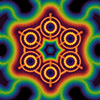Questions posed by an Australian Lawyer
Responses by Dave Nichols (inventor of MBDB)
July 1987
- Would the effects of MBDB class it as an Hallucinogen?
- Would activities like driving be impaired by MBDB?
- Are there any side effects recognised?
- Is there any comedown or hangover?
- How do effects, potency and chemical structure compare with MDMA?
- The N-methyl usually attenuates hallucinogenic activity by about 10-fold.
- The (+) isomer was more active; for hallucinogens the (-) isomer is more active.
- The alpha-ethyl in the side chain abolishes hallucinogenic activity;
MBDB still retains its activity.
- How do effects compare with alcohol - particularly noting Shulgin's comments in PiHKAL?
No, absolutely not, and even less so than MDMA. MBDB has an ethyl group
attached to the side chain (see below). When you do this to an
hallucinogenic phenethylamine derivative, it completely abolishes its
hallucinogenic activity.
I think driving is impaired by any form of intoxication. Clearly, MBDB
causes a form of intoxication. While I suspect that driving impairment
after MBDB might be less than after alcohol or even marijuana, I could not
prove that assertion.
I do not think that there has been wide enough use of this substance to know
that. My best guess is that the side effects might resemble those of MDMA,
or MDE, but based on the animal studies we carried out the compound ought to
be even more benign than MDE.
Again, I do not think there has been enough use of this compound to know.
There are no residual physical aftereffects that I have heard of.
MBDB has, in general, effects similar to MDMA. However, it is my impression
that the nature of the effects with MBDB is much more variable. Some
individuals reported that they experienced effects almost identical to MDMA,
while others found the substance even dysphoric. Clearly, on average, the
compound does not produce the degree of euphoria, and feeling good, that is
produced by MDMA. This has not been accurately quantitated, but is probably
evidenced by the fact that there has been relatively little trade in this
substance in the decade since its report. The potency is also somewhat
lower. 125 mg of MDMA would be similar to perhaps 175 mg of MBDB. These
are just "ball park" guesses. The chemical structure differs from MDMA
slightly. The side chain of MDMA has a methyl group attached to the alpha
position, while the side chain of MBDB has an ethyl. Otherwise, the
structures are the same.
MDMA Ar-CH2CHNHCH3 MBDB Ar-CH2CHNHCH3 | | CH3 CH2CH3I think the two are "strikingly similar," and in fact MBDB was designed to
be an analogue of MDMA that could not be classified as an hallucinogen. In
the mid 1980s, MDMA was being classified by the legal authorities as an
"hallucinogenic amphetamine" and that was the basis for the initial legal
controls. We designed MBDB with the specific intent to find a compound that
could not be classified in that way because of the fact that the alpha-ethyl
group in the side chain absolutely destroys hallucinogenic activity. When
MBDB was made and found to be active, this activity could NOT be
hallucinogenic activity, and we therefore named the class entactogens. We
did enough animal work (using drug discrimination) and in vitro studies to
show that MBDB did not fit the profile of an hallucinogen at all.
While the authorities still tended to call MDMA an hallucinogenic
amphetamine (though less so today), MBDB had feature 3. in the list below to
set it even further apart from MDMA, which only had the first two items to
argue against it being an hallucinogen. I think now that MDMA is referred
to by the authorities as a "novel psychoactive agent."
I don't think I would compare the effects with alcohol. Alcohol dulls the
senses and is a CNS depressant. Reports I have heard regarding MBDB suggest
that it produces clarity of mind, not sluggish thinking.
We haven't done much with MBDB for a long time. We still routinely use it
as a training drug in our rat studies, because the effects it produces are
mediated by serotonin release and we have been interested in that effect.
Dr Dave Nichols, Purdue University


